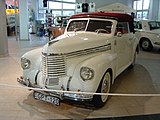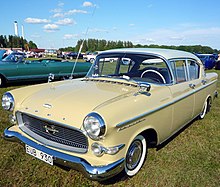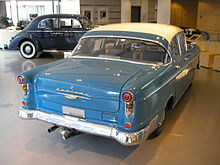Opel captain
The Opel Kapitän from the German automaker Opel was produced between late 1938 and early 1970. First, he was a model of the upper middle class and got into the KAD-A series from 1964 to the upper class on.
Most of the Kapitän models had six-cylinder in - line engines with a displacement of 2.5 to 2.8 liters and a self-supporting body , with the Kapitän A from 1965 there were also eight-cylinder V-engines with 4.6 to 5.4 liters.
Captain '39 (1938-1940)
The Kapitän was the last Opel model constructed before the Second World War . It was introduced at the end of 1938 as the successor to the Opel Super 6 and presented at the Geneva Motor Show in spring 1939 . The pre-war captain was available as a sedan with two or four doors and as a convertible. It had the same 2.5-liter engine as the Super 6, but a self-supporting body and front independent suspension with double wishbones instead of the Dubonnet suspension .
Until the cessation of civilian car production at Opel in autumn 1940, 25,371 units had been produced. In 1943 three more individual vehicles followed.
The purchase price for the two-door sedan was 3575 Reichsmarks (RM), the four-door sedan cost 3975 RM and the four- to five-seat four-window convertible 4325 RM. The car was also a sales success abroad.
In addition, the bodywork companies Gläser in Dresden and Hebmüller in Wülfrath produced two-seater convertibles. These are included in the total production number of 248 chassis or parts superstructures for special bodies.
Captain '48 (1948–1950)
In December 1947, production of the Olympia was initially resumed. From October 1948 the Kapitän was also produced again in a slightly revised form, but only as a four-door sedan with portal doors . Noticeable differences the now round headlights and detail changes such as u. a. Bumpers with stronger horns and hubcaps. With the 2.5-liter in-line engine with 55 hp (40 kW) and three-speed gearbox with center shift lever, it reached a top speed of 126 km / h.
By April 1950, 12,936 copies were built.
Captain '50 (1950–1951)
The Captain '50 received some changes and improvements. The most striking feature is the newly introduced steering wheel gearshift ("remote control"), a new dashboard (like that of the later Kapitän '51) and a new design of the interior trim and upholstery materials (stripes). The compression of the 2.5 liter engine was increased slightly from 6.0: 1 to 6.1: 1.
The Kapitän '50 produced 17,470 copies between May 1950 and February 1951.
Captain '51 (1951–1953)
The Kapitän '51 represented the first signs of the German economic miracle with a modernized body, undivided rear window, significantly more chrome and a more powerful 58 hp (43 kW) engine. The car was extremely popular in the 1950s and a status symbol. At times it was third in the registration statistics after VW Beetle and Opel Olympia Rekord .
From March 1951 to July 1953 a total of 48,587 vehicles were built. The price was 9,250 DM (from August 1, 1951: 9,600 DM).
| Technical data Opel Kapitän 1948–1953 | |||
| Opel Captain: | 1948-1950 | 1951-1953 | |
|---|---|---|---|
| Engine: | 6-cylinder in-line engine (four-stroke) | ||
| Displacement: | 2473 cc | ||
| Bore × stroke: | 80 × 82 mm | ||
| Performance at 1 / min: | 55 hp (40 kW) at 3500 | 58 hp (43 kW) at 3700 | |
| Max. Torque at 1 / min: | 142 Nm at 1700 | 144 Nm at 1700 | |
| Compression: | 6.0: 1 from May 1950 6.1: 1 | 6.25: 1 | |
| Mixture preparation: | 1 downdraft carburetor (Opel / Carter) | ||
| Valve control: | Overhead valves, bumpers and rocker arms (side camshaft, spur gears) | ||
| Cooling: | Water cooling | ||
| Transmission: | 3-speed gearbox, central or (from May 1950) steering wheel shift | ||
| Front suspension: | Independent suspension on double wishbones , coil springs | ||
| Rear suspension: | Rigid axle, 2 semi-elliptical leaf springs with 7 leaves each | ||
| Brakes: | hydraulically operated drum brakes, Ø 230 mm | ||
| Steering: | Snail and roller | ||
| Body: | Sheet steel, self-supporting | ||
| Track width front / rear: | 1348/1326 mm | ||
| Wheelbase: | 2695 mm | ||
| Length: | 4620 mm | 4715 mm | |
| Empty weight: | 1230 kg | 1240 kg | |
| Top speed: | 126 km / h | 130 km / h | |
| 0-100 km / h: | 29 p | 24 s | |
| Consumption (liters / 100 kilometers): | 13.0 N | 12.0 N | |
| Price (DM): | 9950 | 9600-9850 | |
Captain '54 (1953–1955)
In the fall of 1953, the revised Kapitän '54 received an American-style pontoon body with a distinctive "shark's mouth" grille. All the doors were now hinged at the front and the windshield was undivided. The rear window was divided into three parts with a wide central pane and two small, more curved outer panes. The engine's output rose to 68 hp (50 kW) and the top speed to 138 km / h.
In its production period from November 1953 to July 1955, 61,543 units were built. The purchase price was DM 9,500 (from January 3, 1955: DM 8,990).
Captain '56 / '57 (1955–1958)
The series, which started in August 1955, received a minor facelift . The bonnet was smoothed and the radiator grille now consisted of vertical bars instead of the "shark's mouth". The rear fenders received small "fins". The engine output has been increased to 75 hp (55 kW).
The Kapitän '57 was offered from August 1956. For the first time, there was a better equipped L version of this model from May 1957 for an extra charge of 900 DM, which offered, among other things, individual front seats, dimming interior mirrors, reversing lights and more. An overdrive (2nd and 3rd gear) was also available.
A total of 92,555 vehicles were built by Kapitän '56 and Kapitän '57 by July 1958.
| Technical data for the Opel Kapitän 1953–1958 | |||
| Opel Captain: | 1953-1955 | 1955-1958 | |
|---|---|---|---|
| Engine: | 6-cylinder in-line engine (four-stroke) | ||
| Displacement: | 2473 cc | ||
| Bore × stroke: | 80 × 82 mm | ||
| Performance at 1 / min: | 68–71 hp (50–52 kW) at 3700 | 75 hp (55 kW) at 3900 | |
| Max. Torque at 1 / min: | 165-170 Nm at 1700 | 170 Nm at 1700 | |
| Compression: | 7.0: 1 | 7.1: 1 | |
| Mixture preparation: | 1 downdraft carburetor (Opel / Carter) | ||
| Valve control: | spur gear driven side camshaft, tappets, bumpers, rocker arms and overhead valves | ||
| Cooling: | Water cooling | ||
| Transmission: | 3-speed gearbox, steering wheel gearshift | ||
| Front suspension: | Independent suspension on double wishbones , coil springs | ||
| Rear suspension: | Rigid axle, semi-elliptical leaf springs with 5 spring layers | ||
| Brakes: | hydraulically operated drum brakes, Ø 230 mm | ||
| Body: | Sheet steel, self-supporting | ||
| Track width front / rear: | 1341/1372 mm | 1372/1372 mm | |
| Wheelbase: | 2750 mm | ||
| Length: | 4710 mm | 4735 mm | |
| Empty weight: | 1250 kg | 1300 kg | |
| Top speed: | 138 km / h | 140 km / h | |
| 0-100 km / h: | 23 p | 20 s | |
| Consumption (liters / 100 kilometers): | 12.0 N | 11.5 N | |
| Price (DM): | 9,660 | 9,350-10,250 | |
Captain P 2.5 (originally "P", 1958–1959)
The Opel Kapitän P 2.5 appeared in July 1958 at a price of 10,250 DM, with a 2.5-liter engine and an output of 80 hp (59 kW). An L version (surcharge DM 750) and an overdrive gear (surcharge DM 650) were also available.
The styling of the body with plenty of chrome trim, the tail fins and panoramic windows at the front and rear was based heavily on American automobiles of that time and was therefore only very limited among German buyers. The color choice of the paintwork was plentiful. Because of the keyhole-shaped rear lights, this model is known today as the “keyhole captain”, sometimes also as the captain “P 1” (the “P” stood for the panorama windows).
Because of the steeply sloping roof, the rear panoramic window and the somewhat narrow doors, getting into the rear was uncomfortable for adults. In addition, the view of the rear passengers to the side was restricted and the low roof caused poor visibility to the rear, so the headroom was also restricted.
From July 1958 to June 1959 34,842 Kapitän P 2.5 were built. This model was replaced after just one year.
Captain P 2.6 (1959–1963)
A new captain appeared in the summer of 1959: the new body had flatter, stretched lines with an even larger panoramic window at the front. The heavily pulled-down roof at the rear, which was criticized in the previous model, was changed so that it was easier to get back in at the back. With the displacement increased to 2605 cm³, the engine output rose to 90 hp (66 kW) and the top speed to 150 km / h.
The car became the most successful captain ever built. After overdrive , which was used until mid-1960 , Opel offered an automatic 3-speed "Hydramatic" transmission for this model for the first time as an extra from the summer of 1960 and, from 1962, power steering . In addition, there was again a higher-quality equipment variant ("L" version). Opel also refrained from presenting a modified vehicle based on the American model almost every year.
The often incorrectly used type designation "Kapitän P-LV" especially for the Kapitän P 2.6 stems from an error in the Oswald standard work that is copied over and over again: The designation "LV" is Opel-internal and means " Four-door sedan ”, analogously to this, for example,“ LZ ”stands for two-door sedan (see spare parts catalog). "LVL" stands for "limousine four-door luxury". The old Kapitän model was initially called Kapitän P and later - to distinguish it from the P 2.6 with a larger engine - P 2.5. There was also a two-door coupé-like variant of the Opel Kapitän P 2.6 in very small numbers, which was built by Autenrieth in Darmstadt. Two of them are still known, one is ready to drive.
From July 1959 to December 1963 a total of 145,616 Kapitän P 2.6 were built. The last new registrations were recorded in February 1964. The P 2.6 was the last Kapitän in the six-cylinder class that was even ahead of Daimler-Benz in the registration statistics.
| Opel Kapitän P (P 2.5) (1958–1959) |
Opel Kapitän P 2.6 (1959–1963) |
|
|---|---|---|
| Engine: | 6-cylinder in-line engine (four-stroke) | |
| Displacement: | 2473 cc | 2605 cc |
| Bore × stroke: | 80 × 82 mm | 85 x 76.5 mm |
| Performance at 1 / min: | 80 PS (59 kW) at 4100 | 90 hp (66 kW) at 4100 |
| Max. Torque at 1 / min: | 173 Nm at 1900 | 186–191 Nm at 1900 |
| Compression: | 7.5: 1 | 7.8-8.2: 1 |
| Mixture preparation: | 1 Opel downdraft carburetor (Carter license) | |
| Valve control: | Overhead valves, bumpers and rocker arms side camshaft with spur gear drive |
|
| Cooling: | Water cooling | |
| Transmission: | 3-speed gearbox, steering wheel shift P 2.6 from 1961 aW with Hydramatic three-speed automatic |
|
| Front suspension: | individually on double wishbones , coil springs | |
| Rear suspension: | Rigid axle, four-layer semi-elliptical leaf springs | |
| Brakes: | hydraulically operated drum brakes, Ø 230 mm |
hydraulically operated drum brakes, Ø 255 mm |
| Body: | Sheet steel, self-supporting | |
| Track width front / rear: | 1376/1372 mm | 1378/1374 mm |
| Wheelbase: | 2800 mm | |
| Length: | 4764 mm | 4831 mm |
| Empty weight: | 1310 kg | 1340-1380 kg |
| Top speed: | 144 km / h | 150 km / h |
| 0-100 km / h: | 20 s | 16-17 p |
| Consumption (liters / 100 kilometers): | 12.0 S. | 12.0-13.0 S. |
| Price (DM): | 10,250-11,650 | 9.975-11.975 |
Opel Kapitän A (1964–1968)
In February 1964 Opel began production of the upper classes -Modellreihe KAD-A and hence that of the Opel Captain A on. The resulting gap in the upper middle class was soon closed by the Commodore series.
The straight body without panorama windows is the same for all, Admiral and the top model Diplomat are better equipped. The maximum output of the 2.6-liter engine was increased to 100 hp (74 kW), but in August 1965 a completely new engine with 2784 cm³ and 125 hp (92 kW) was introduced, which did more justice to the big car. A four-speed gearbox was introduced.
Its production ceased in November 1968. The staggered by the equipment model K apitän- A dmiral- D iplomat has since been shortened to "KAD". With this model series, Opel lost its first place in the German new car registration statistics for the six-cylinder class.
Opel Kapitän B (1969–1970)
In March 1969, the KAD-B series appeared, including the Kapitän B. The chassis was improved with a De-Dion rear axle , the body slightly reduced (length and width by approx. 5 cm) and modernized.
The production of the Kapitän B was stopped in May 1970, with which Opel gave up the name Kapitän. The KAD-B series continued with Admiral (until July 1976) and Diplomat until July 1977.
The situation today
The Opel Kapitän is a popular model among collectors and enthusiasts. Basically, the captain is an extremely reliable vehicle, previous rust problems are no longer a problem after a good restoration, as the vehicles are usually no longer exposed to daily use and especially to winter road salt. All year models are recommended and popular. The rare convertible versions are particularly sought after, the 51 captain, but also the once disdained P 2.5 (keyhole captain) has developed into a sought-after variant.
While the supply of technical parts is satisfactory, there is a lack of sheet metal parts; especially fenders and especially chrome parts are rare. Many of these chrome parts are now reproduced. Exhaust systems (partly made of stainless steel), tires (even various whitewall offers) are no problem, even if partly quite expensive. Parts that are seldom to be found are also reproduced. The Alt-Opel interest group, founded in 1972, and the Opel-Kapitän Club offer a lively club life with many procurement opportunities and technical assistance.
Popular culture
The songwriter Reinhard Mey dedicated one of his songs to his father, the 51 captain . It is about the shared dream of father and son to drive up one day in a snow-white captain - the epitome of luxury - but which never happens because the father cannot afford the captain and at some point dies. The song ends with the line: "But if there should be a heaven, then I'll finally see it: Because then my old man will pick me up in a snow-white 51 captain!"
Others
The two millionth Opel that rolled off the production line in Rüsselsheim on November 9, 1956, was an Opel Kapitän with a gold-colored roof and gold-plated trim.
proof
- ↑ Lyrics of the 51 captain on reinhard-mey.de
- ↑ 80 years of the great Opel: Flagship parade at the Techno Classica . In: media.gm.com . ( opel.de [accessed on September 10, 2017]).
literature
- Werner Oswald : German Cars 1945–1975 . Motorbuch Verlag, Stuttgart 1975, ISBN 3-87943-391-7 , pp. 72-142.
- Eckhart Bartels: The Opel Kapitän book Podszun Verlag, Brilon 1987 and 1999, ISBN 3-86133-193-4
Web links
- Interest group captain - admiral - diplomat Sauerland
- Opel captain admiral diplomat
- Opel Captain P2.5
- Opel Kapitän on oldtimerwebseiten.com






















